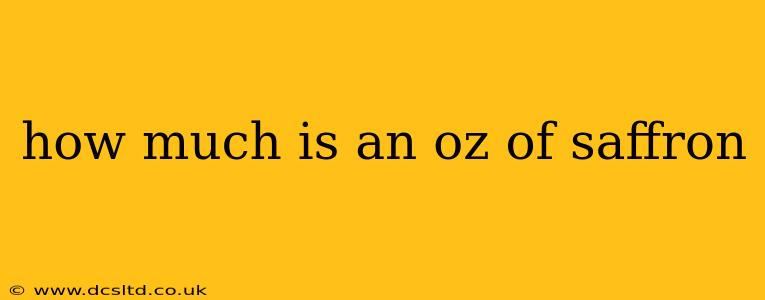Saffron, the world's most expensive spice, commands a hefty price tag due to its labor-intensive cultivation and low yield. But how much does an ounce actually cost? The answer, unfortunately, isn't a simple number. The price fluctuates significantly based on several factors, making it crucial to understand what influences the final cost.
What Determines the Price of Saffron?
Several key factors contribute to the wildly varying price of saffron per ounce:
-
Grade and Quality: Saffron is graded based on its appearance, aroma, and flavor. Higher-grade saffron, featuring longer, vibrant red stigmas, will cost significantly more than lower-grade saffron with shorter, paler strands or a mix of stigmas and styles. The quality directly impacts the price per ounce. Premium saffron, often labeled as "Grade 1" or "Coupe 1," fetches the highest prices.
-
Origin: The geographical origin plays a significant role. Saffron from certain regions, particularly those with ideal growing conditions and long-standing cultivation traditions (like Iran, Spain, and Kashmir), is often considered superior and commands a higher price.
-
Harvest Year and Supply: Like any agricultural product, saffron prices are influenced by the harvest yield. A poor harvest due to weather conditions or other factors can lead to increased prices per ounce.
-
Retailer and Purchasing Method: The price you pay will depend on where you buy it. Smaller, specialized spice shops may offer higher-quality saffron at a premium price, while larger retailers or online marketplaces may offer lower prices but with potentially lower quality. Buying in bulk can often lower the per-ounce cost.
-
Processing and Packaging: The level of care taken in harvesting, cleaning, and packaging also impacts the price. Hand-picked and meticulously processed saffron typically costs more.
How Much Can I Expect to Pay?
Given the variability, providing an exact price is impossible. However, you can expect to pay anywhere from $500 to $5000 or more per ounce for high-quality saffron. Lower-quality saffron might be found for less, but be cautious – the lower the price, the more likely it is that the saffron is of inferior quality, possibly adulterated or simply not the genuine article.
How to Ensure You're Getting Authentic Saffron?
Given the high price point, it's vital to know how to identify authentic saffron. Several indicators can help:
- Appearance: Look for long, deep red stigmas. Avoid saffron that is pale, orange, or contains many yellow styles (the paler part of the flower).
- Aroma: Authentic saffron has a distinct, potent aroma. If it smells weak or bland, it’s likely not high-quality.
- Taste: A small pinch should have a slightly bitter, complex flavor.
- Source: Research the supplier. Reputable suppliers will provide information about the origin, harvesting methods, and grading.
What are the Different Grades of Saffron?
Saffron grading systems vary, but generally, they differentiate based on the length, color, and integrity of the stigmas. The highest grade consists of long, rich red stigmas, while lower grades may include shorter strands and a higher proportion of yellow styles. These distinctions directly influence the price.
Is it Worth the Price?
The exorbitant price of saffron is due to the extensive labor required for its production. Its intense flavor and color add a unique element to culinary creations, making it a worthwhile investment for some, especially in small quantities. However, for everyday cooking, consider its cost-effectiveness carefully.
Conclusion
The cost of an ounce of saffron is highly variable, depending on numerous factors. By understanding these factors, you can make an informed decision when purchasing this valuable spice and ensure you receive the quality you're paying for. Remember to always prioritize quality over quantity, as a small amount of high-grade saffron goes a long way.
